Roman villa of Camino de Albalate facts for kids
The Roman villa of Camino de Albalate is an ancient Roman site. It is located near Calanda in Teruel, a province in Aragon, Spain. This site helps us learn about how people lived long ago during the Roman Empire.
Contents
What Was a Roman Villa?
A Roman villa was like a large country house or estate. Wealthy Romans often owned these villas. They used them as homes, but also as centers for farming. Villas were very important for the Roman economy. They produced food and other goods.
Parts of a Roman Villa
Roman villas usually had different parts. There was often a main house where the owner and their family lived. This part could be quite fancy, with beautiful mosaic floors and painted walls. There were also buildings for farm workers and animals. Storage areas for crops and tools were common too. Some villas even had their own baths or temples.
Life at a Roman Villa
Life at a Roman villa was busy. The owner, often a rich Roman citizen, would manage the estate. Slaves and free workers did most of the hard work. They grew crops like wheat, grapes, and olives. They also raised animals such as sheep and cattle. The villa was a self-sufficient community. It produced almost everything its residents needed.
Discovering Camino de Albalate
Archaeologists are like history detectives. They study old objects and buildings to understand the past. The Roman villa of Camino de Albalate was discovered through archaeological work. When they find a site like this, they carefully dig it up. They look for clues about how people lived there.
What Archaeologists Found
At Camino de Albalate, archaeologists have found remains of buildings. They also found everyday items that Romans used. The mosaic shown in the picture is a great example. Mosaics are pictures made from small pieces of colored stone or glass. They were often used to decorate floors in important rooms. Finding a mosaic tells us that this part of the villa was likely a main living area. These discoveries help us imagine what the villa looked like and how its residents lived.
Why These Sites Are Important
Studying Roman villas like Camino de Albalate is very important. They show us how Roman society was organized. We learn about their farming methods and their daily lives. These sites also teach us about Roman art and architecture. Each discovery adds to our knowledge of the ancient world.
See also
 In Spanish: Yacimiento romano del Camino de Albalate para niños
In Spanish: Yacimiento romano del Camino de Albalate para niños


